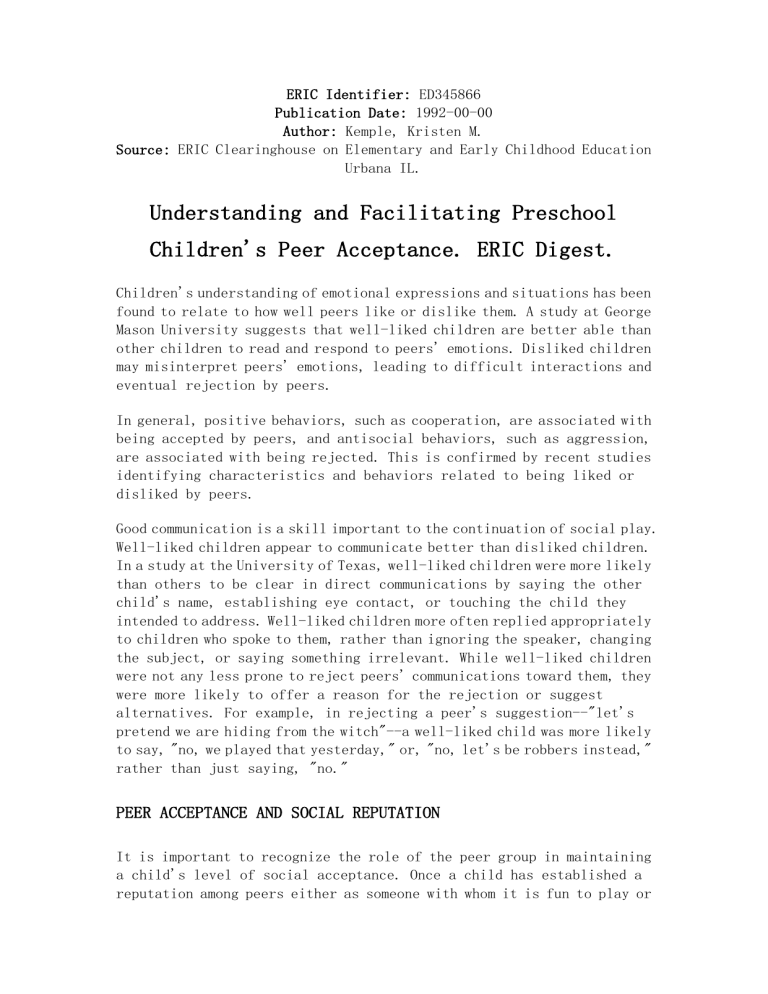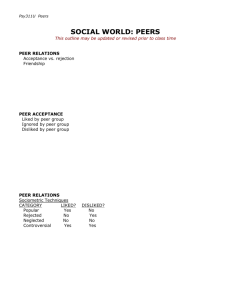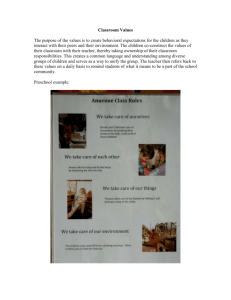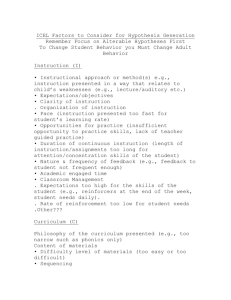ERIC Identifier: ED345866

ERIC Identifier: ED345866
Publication Date: 1992-00-00
Author: Kemple, Kristen M.
Source: ERIC Clearinghouse on Elementary and Early Childhood Education
Urbana IL.
Understanding and Facilitating Preschool
Children's Peer Acceptance. ERIC Digest.
Children's understanding of emotional expressions and situations has been found to relate to how well peers like or dislike them. A study at George
Mason University suggests that well-liked children are better able than other children to read and respond to peers' emotions. Disliked children may misinterpret peers' emotions, leading to difficult interactions and eventual rejection by peers.
In general, positive behaviors, such as cooperation, are associated with being accepted by peers, and antisocial behaviors, such as aggression, are associated with being rejected. This is confirmed by recent studies identifying characteristics and behaviors related to being liked or disliked by peers.
Good communication is a skill important to the continuation of social play.
Well-liked children appear to communicate better than disliked children.
In a study at the University of Texas, well-liked children were more likely than others to be clear in direct communications by saying the other child's name, establishing eye contact, or touching the child they intended to address. Well-liked children more often replied appropriately to children who spoke to them, rather than ignoring the speaker, changing the subject, or saying something irrelevant. While well-liked children were not any less prone to reject peers' communications toward them, they were more likely to offer a reason for the rejection or suggest alternatives. For example, in rejecting a peer's suggestion--"let's pretend we are hiding from the witch"--a well-liked child was more likely to say, "no, we played that yesterday," or, "no, let's be robbers instead," rather than just saying, "no."
PEER ACCEPTANCE AND SOCIAL REPUTATION
It is important to recognize the role of the peer group in maintaining a child's level of social acceptance. Once a child has established a reputation among peers either as someone with whom it is fun to play or
as someone with whom joint play is unpleasant or dissatisfying, this reputation may influence the way other children perceive the child's later behavior. If a negative reputation is developed, helping the child become accepted may require more than a change in the child's behavior; it may also be necessary to point out to the other children when the child's behavior changes and to guide them to respond to the child in positive ways.
HOW CAN TEACHERS AND OTHER ADULTS HELP?
Studies such as those mentioned above suggest important elements to be considered by those who wish to understand why a particular child is unpopular and need to decide what to do to help that child gain social acceptance. To assist a disliked child in gaining acceptance, careful, informed observation is needed.
Observe behavior and note: Does the child have greater success interacting with one or two peers than with larger groups? Does the child often seem to misinterpret the apparent intentions and emotional cues of other children? When rejecting a playmate's suggestion, does the child provide a reason or an alternative idea? Do classmates consistently rebuff or ignore the child's attempts to engage in play, even when the child is using strategies that should work? There is no recipe for facilitating acceptance. To help a child, it is essential to identify the child's areas of difficulty.
STRATEGIES TO CONSIDER
Adults who work with groups of children may feel frustrated in their attempts to help a child achieve social acceptance. Many approaches can be adapted to particular situations and needs of individual children.
Special play activities can be arranged, such as grouping children who lack social skills with those who are socially competent and will thus provide examples for learning effective skills. Planning special play sessions with a younger child may help the socially isolated child.
Research reports that socially isolated preschoolers exposed to play sessions with pairs of younger children eventually become more socially involved in the class than do isolated children who play with children of their own age. The decision to pair a child with a younger or more socially skilled child should depend on whether the child's social isolation is due to ineffective social skills or lack of confidence. Some children have adequate social skills, but are anxious and inhibited about
using them. Opportunities to be the big guy in play with a younger child may give the inhibited child a needed boost of social confidence.
Sometimes disliked children behave aggressively because they don't know how to resolve conflicts. Planned activities can help children generate alternative solutions to difficult social situations. Skits, puppet shows, or group discussions that present hypothetical situations can encourage a wide range of ideas for potential solutions. Such methods can increase the number of appropriate strategies, such as taking turns or sharing, that are available to the children. However, to effectively implement such newly learned strategies in the classroom, children must be given on-the-spot guidance when real conflict situations occur. To help with conflict resolution, the adult can encourage the children involved to voice their perspectives, generate potential solutions, and jointly decide on and implement a mutually acceptable solution.
When a child has difficulty entering ongoing play, an adult can steer the child toward smaller or more accepting groups, or can structure the environment to include inviting spaces for private small group or one-on-one play. A loft, a tent, or a large empty box might make an inviting space. When a child asks, "Can I play?" the teacher can guide the child in observing the ongoing play, figuring out the group's theme and purpose, and thinking of a role to play or of ways to contribute to the group.
On-the-spot guidance by adults can facilitate communication, which contributes to successful play. A child who rejects playmates' ideas without offering explanations or alternatives could be told, "Ben I don't think Tom understands why you don't want to play store. Can you tell him why?" or "Can you tell him what else you could do together?" A disliked child having difficulty reading others' emotional cues might be given a suggestion--"Look at Mary's face. Do you think she likes it when you poke her?"
In addition to using techniques that focus on the disliked child, adults may need to translate for the peer group the unpopular child's behavior and apparent intentions. For example, an adult might say, "Thomas wants to play with you. If you don't need another father, who could he be instead?" However, when intervention focuses on the peer group, adults should not force peers to play with a disliked child. This may cause resentment and increase rejection of the child.
The teacher's attempts to help a disliked child find a comfortable niche in the peer group may prove more successful if the child's family is involved, either directly or indirectly. After describing to the parent what techniques are being tried in the classroom, the teacher may suggest
how the parent can use some of the strategies to help the child play with peers at home or interact with siblings. Children who feel good about themselves and experience loving family relationships may bring their expectations of acceptance and success to the peer group. Such expectations can become self-fulfilling prophecies.
For the child whose poor self-concept reflects difficulties in the child's family, parent conferences in which the teacher can offer support may be helpful. Literature on such topics as positive discipline and effective parent-child interaction can be offered on a parent reading shelf or bulletin board. Parent discussion groups, facilitated by a knowledgeable professional, can provide information about the importance of social competence and guidance strategies that can help parents facilitate their child's development.
EDITOR'S NOTE: This is the second in a series of three ERIC/EECE digests that focus on children's peer relationships as educational contexts.
These digests are adapted from articles that originally appeared in the
Fall 1991 (Vol. 19, No. 1) issue of the EARLY REPORT of the University of Minnesota's Center for Early Education and Development.
FOR MORE INFORMATION
Denham, S.A., McKinley, M., Couchoud, E.A., and Holt, R. "Emotional and
Behavioral Predictors of Preschool Peer Ratings." CHILD DEVELOPMENT 61
(1990): 1145-1152.
Furman, W., Rahe, D., and Hartup, W.W. "Rehabilitation of Socially
Withdrawn Preschool Children Through Mixed-Age and Same-Age
Socialization." CHILD DEVELOPMENT 50 (1979): 915-922.
Hazen, N.L., and Black, B. "Preschool Peer Communication Skills: The Role of Social Status and Interaction Context." CHILD DEVELOPMENT 60 (1989):
867-876.
Hazen, N.L., Black, B., and Fleming-Johnson, F. "Social Acceptance:
Strategies Children Use and How Teachers Can Help Children Learn Them."
YOUNG CHILDREN 39 (September 1984): 23-26.
Kemple, K.M., Speranza, H., and Hazen, N.L. "Cohesive Discourse and Peer
Acceptance: Longitudinal Relationships in the Preschool Years."
MERRILL-PALMER QUARTERLY: in press.
Rogers, D.L., and Ross, D.D. "Encouraging Positive Social Interaction
Among Children." YOUNG CHILDREN 41 (March 1986): 12-17.
Spivack, G., and Shure, M. SOCIAL ADJUSTMENT OF YOUNG CHILDREN: A
Cognitive Approach to Solving Real-life Problems. San Francisco:
Jossey-Bass, 1974.
Stein, L.C., and Kostelnik, M.J. "A Practical Problem-solving Model for
Conflict Resolution in the Classroom." CHILD CARE QUARTERLY 13 (1984):
5-20.




